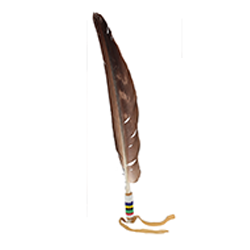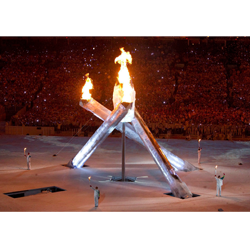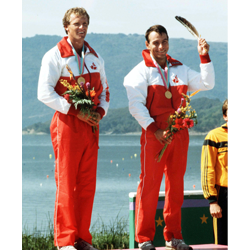An eagle feather is lifted up towards the sky much like an athlete raises up an Olympic Torch towards the sky. An eagle feather connects to many Indigenous Peoples’ cultural identity, spirit and love of the Creator through sacred teachings often shared by grandparents, Elders and/or Knowledge Holders. The Torch holds a flame that connects with the fire/light inside of us, which can motivate people to aspire to achieve their goals and not give up. The light from a flame can remind us of the night sky filled with stars, which we can look to for guidance and connect to a sense of self-worth and spiritual guidance.
Each Olympic Games is given a slogan. For example, the 2002 Olympic Winter Games’ motto was “Passion Lives Here”; in 2006, it was “Light the Fire Within”; and, in 2010, it was “With Glowing Hearts,” all of which relate to the inner sacred fire of Olympians.[1]
Torches, medals and even mascots also reveal specific symbolism that relates to the respective Olympic year’s theme. For instance, the Turin 2006 medals were designed to “reveal the place where the heart beats, the symbol of life itself…focusing attention on the athlete’s vital energy and human emotions.” [2] Likewise, the Vancouver 2010 Olympic Torch bore the emblem “With Glowing Hearts, Des plus brillants exploits”.[3]
When Alwyn Morris won his Olympic Gold Medal competitive canoe-kayak sprint in 1984, he proudly raised an eagle feather to the sky to pay tribute to his grandparents who raised him – he was encouraged to do this by Chief Wilton Littlechild who also had been raised by his grandparents. A quarter of a century later, Hall of Famer Chief Wilton Littlechild was named the first Indigenous Torch Bearer and an Ambassador for the 2010 Olympic Winter Games, and the same flame was later carried by fellow Hall of Famer Alwyn Morris. When Morris ran the 2010 torch through the Kahnawake reserve, he was a beacon of hope for many Mohawk youth, igniting their inner flames, and said: “What a great thing to rekindle the [Olympic] spirit in the community and give some hope and dreams to some very young people here who may want to follow in those footsteps.”[4]
[1] Olympic Slogans. theolympicdesign. (n.d.). Retrieved November 18, 2021, from https://www.theolympicdesign.com/olympic-design/slogans/.
[2] IOC. (2021, October 13). Turin 2006 Olympic medals – design, history & photos. Olympics.com. Retrieved November 18, 2021, from https://olympics.com/en/olympic-games/turin-2006/medal-design.
[3] CBC/Radio Canada. (2009, December 9). Olympic torch cheered in Mohawk Community | CBC News. CBCnews. Retrieved November 18, 2021, from https://www.cbc.ca/news/canada/montreal/olympic-torch-cheered-in-mohawk-community-1.776911.
[4] CBC/Radio Canada. (2009, December 9). Olympic torch cheered in Mohawk Community | CBC News. CBCnews. Retrieved November 18, 2021, from https://www.cbc.ca/news/canada/montreal/olympic-torch-cheered-in-mohawk-community-1.776911.

Alwyn Morris brought this Eagle Feather to the 1984 Olympic Games in Los Angeles, raising it on the podium after his Gold Medal win with partner Hugh Fisher in the K-2 1000m event.
Courtesy of Alwyn Morris.

Pictured here is the 1984 Summer Olympic torch with the slogan “Play a Part in History.” An Eagle Feather is lifted up towards the sky much like an athlete raises up an Olympic Torch towards the sky. When Alwyn Morris won his Olympic Gold Medal in canoe-kayak sprint, he proudly raised an Eagle Feather to the sky to pay tribute to his grandparents who raised him.
Courtesy of Canada’s Sports Hall of Fame.

The 2010 Olympic Winter Games slogan was “With Glowing Hearts,” which also relates to the inner sacred fire of Olympians. The torch relay for the 2010 Olympic Winter Games travelled through over 1000 communities in Canada before arriving in Vancouver. Hall of Famers Alwyn Morris and Chief Wilton Littlechild carried the torch through their communities of Kahnawake and Maskwacîs.
Courtesy of Canada’s Sports Hall of Fame.

The 2010 Paralympic Winter Games in Vancouver marked the first time that the Paralympic torch relay had its own unique emblem – “Spark Becomes Flame” which shows a human figure with its arms raised and joined, much like a candle’s flame. Contained within the arms is the glow of the fire within everyone, symbolizing the moment when imaginations are ignited and dreams are born.
Courtesy of Canada’s Sports Hall of Fame.

To open the 2010 Winter Olympics in Vancouver, four designated individuals who encapsulate Canadian excellence in sport were tasked with lighting the Olympic Cauldron. The sacred Olympic flame connects with the fire/light inside each of us, as well as the light we turn to for guidance in the night sky that is filled with stars, and motivates humanity to aspire and not give up. The Olympic flame’s stories, values, and ceremony are connected with the symbolism of fire.
CP2626569, THE CANADIAN PRESS/Nathan Denette.

Bryan Trottier was presented with this Eagle Feather at a ceremony in 2014. The sacred eagle feather, like the eagle itself, represents honesty, truth, majesty, strength, courage, power, and freedom. The eagle is highly revered and considered sacred because he soars higher than any creature. The eagle is also considered a messenger to Creator so to wear or hold an eagle feather shows honour and respect to Creator.
Courtesy of Bryan Trottier.


